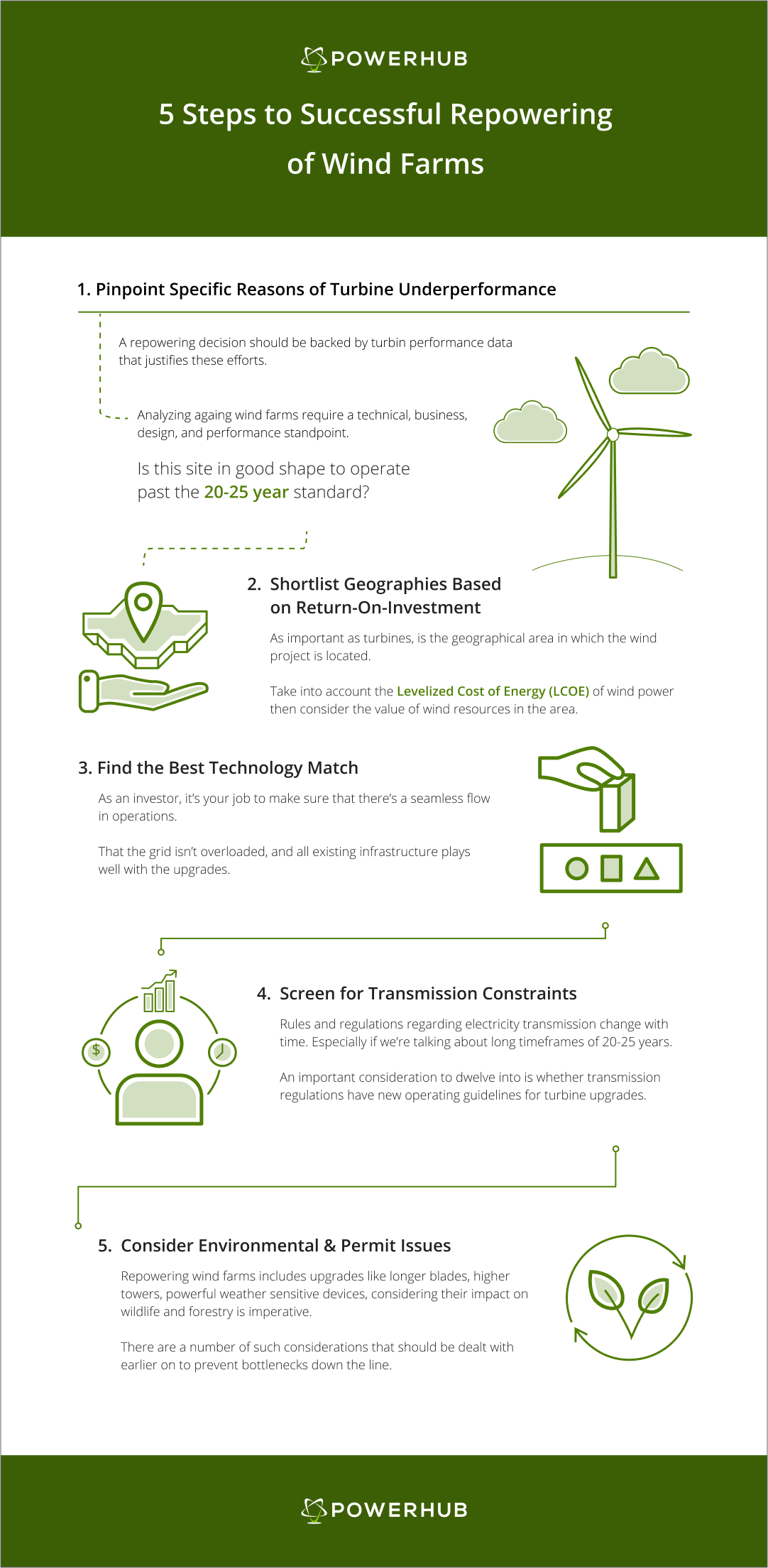The decision to repower wind farms is, perhaps, the most important one on the minds of investors, asset owners and managers today. As Global Wind Energy Council (GWEC) states, about 34GWs of turbine capacity is nearing the end of its peak operating life as of 2020. This first generation of wind farms need a plan.
Literally speaking, repowering a fleet of turbines is an extension strategy. It equips these machines with the necessary upgrades (considering they’ve been in operation for the past 2 decades, they need some) to generate optimal power. These upgrades may include replacing physical components like blades, or technical upgrades to software and sensitivity alarms.
Generally, repowering may seem like the obvious choice. And the best way to continue with an existing wind farm. However, there’s a lot to consider before investors or asset owners choose this strategy.
5 Steps to Successful Repowering of Wind Farms
The following five-point plan provides a systematic approach to repowering wind farms.

1. Pinpoint Specific Reasons of Turbine Underperformance
A repowering decision must never be ad-hoc. It should be backed by turbine performance data that justifies these efforts. As an investor looking for sites to repower, your aim will be to identify the specific reasons for underperformance.
Let’s remember that this process is not just about numbers and sales. Analyzing aging wind farms for repowering involves a holistic approach. From a technical, business, design, and performance standpoint.
Doing so will help outline a plan and schedule for repowering the wind project. Knowing the specific reasons means you contact suppliers and IT ops teams early in the process to talk about possible substitutions, their costs, and the percentage of output increase.
Moreover, a deeper look at performance history can answer questions like whether this site is in good shape to operate past the 20-25-year standard? Or if it was a solid contributor to the overall KPIs of the portfolio. Referring to a digital platform that centralizes this information makes this process so much simpler than manually sifting through data.
2. Shortlist Geographies Based on Return-on-Investment
As important as the turbines, is the geographical area in which the wind project is located. Undeniably, some areas are way more valuable for wind energy than others. Where is the site under your consideration situated?
Ideally, your goal should be to maximize the value of repowering a wind farm. And for that, you must understand the economics of energy. Take into account the Levelized Cost of Energy (LCOE) of wind power. Then consider the value of wind resources in this area.
Tying in the operating history of the turbines as well will give you an idea of the potential returns per investment. It will tell you whether revenue generated per unit of electricity is enough to recover costs of the repowering investment.
3. Find the Best Technology Match
Now on to the turbine itself. Wind farm technology has developed at an accelerated rate since most of the global projects went online. Hence, you may have a whole variety of upgrades to choose from. But not all of these may be optimal for the repowering strategy you are pursuing.
Let’s assume you’re thinking of a partial repowering of the wind farm. Finding the best match between new technology, and the existing one becomes a top concern. As an investor, asset owner or manager, it’s your job to make sure that there’s a seamless flow in operations. That the grid isn’t overloaded, and all existing infrastructure plays well with the upgrades.
Therefore, a thorough analysis of OEM offerings should be a definite step towards your repowering efforts.
4. Screen for Transmission Constraints
Rules and regulations regarding electricity transmission change with time. Especially if we’re talking about long timeframes of 20-25 years.
An important consideration to delve into is whether transmission regulations have new operating guidelines for turbine upgrades. Do they require adding more capacity to the grid now that newer installations are more efficient?
Therefore, reviewing and screening interconnection agreements should be on your radar. If you must face transmission upgrade assessment costs, does repowering still make sense? In simple words, weigh the costs with the potential benefits you expect in the future.
5. Consider Environmental & Permit Issues
Last, but never the least. Environment and permitting considerations are important. Since repowering wind farms includes upgrades like longer blades, higher towers, powerful weather sensitive devices, considering their need for additional studies is imperative. Do turbine blade upgrades present a challenge? Has a study been conducted in the area under question? Does a new study need to be conducted? Have regulations changed?
There is an ongoing debate in wind circles about the effect of wind farm development on birds. Do turbine blade upgrades present a challenge? Has a study been conducted in the area under question?
Moreover, this is also the stage to reassess the potential impact of the project on surrounding neighbours. Do they have any concerns that can be addressed prior to repowering the wind farms? Will you need new permits from aviation if taller towers are chosen?
There are a number of such considerations that should be dealt with earlier on to prevent bottlenecks down the line.
Conclusion
This 5-point plan certainly make one thing clear: the decision to repower wind farms can not be made by an investor or asset executive alone. It requires teamwork, and a practical assessment of costs and benefits. It makes an overwhelming decision simpler, yet comprehensive.
More importantly, once this assessment is made, it empowers stakeholders to answer the question: which repowering efforts should I invest my dollars into?



